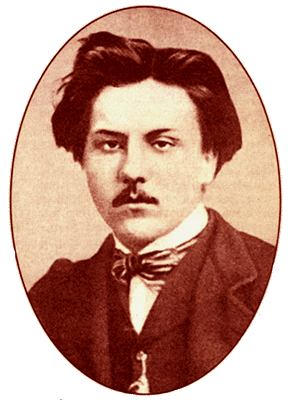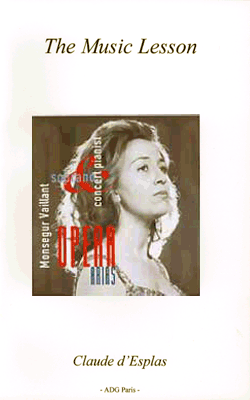|
|
 Indulging in memories, Gabriel Fauré admits to the ‘Echo de Paris’ (April 1924) that he grew up in ‘a region altogether beautiful, smiling, magnificent, splendid’, adding: ‘I even thought about it so often when I was composing... that many of my works almost certainly carry the mark of the walks I took as a very small boy in this beautiful land of my fathers...’ The little Gabriel (should one say Ariel,) was born on 12th May 1845 in rue Major, Pamiers, into an Ariège family of Calibans of the anvil (‘fauré’ means ‘blaksmith’ in the langue d'oc), who had been successively blacksmiths and butchers before taking to the pen. On his mother's side, the Lalène-Laprade, descended from a veteran officer of the 1st Empire and hold their rank at Gailhac-Toulza, a market-town situated a few miles from Canté, the village which provided a Pope for the Inquisition: ‘the Ariège produces men and iron’ was a lapidary statement by Bonaparte. Alberich's hammer - Gabriel Fauré hears its sonorous echoes rise from the smithy at Moulinéry when his parents settle down in the premises of the Ecole Normale of Montgauzy, which according to one of its Heads, looks like the ‘Flying Dutchman’ from a misty distance; the 4-year-old child will bring back to the composer's memory the symphony of bells ringing out in Ganac and Cadirac at the time of the angelus, which marks the beginning of the Andante of the 2nd quartet. The Murmuring Forest - Siegfried-Gabriel listens to it on the slopes of the Prat d'Albis or under the big cedars in the School playground above which circle, like furious Rolands, the September ringdoves: they hardly recognize the miraculous chapel built by Charlemagne and where was to be found this harmonium... (‘each time I was able to get away, I ran there and enjoyed myself’), which was replaced by the Debain 1867 which helped with the creation of the Wedding at Cana (Lé Maridadge dé Cana). The Pilgrims' March, Tannhäuser-Gabriel accompanies it when he joins the organ of some orthodox capital like Rennes or Paris, for lack of indulgent Rome. But Father Almire Le Rebours, priest at the Madeleine, reminds him only very little of the moving good-heartedness of the Priest of Rieucros who would come and fetch the small Gabriel-Lohengrin - all dressed in white - from his nanny at Verniolle, before taking him away at the trot of ‘la cabalho’ (the mare) who pulls the cart towards Mirepoix where the assistant-master Pagnol was forging a Topaze soul for himself and to the very border of the Aude, near Saint-Gaudéric where one dances la ‘Troumpuso’ (the deceiveress) so well that even Raymond Escholier and Roger Ducasse were mistaken, but not the honorary Secretary of fhe Council of Pamiers when he used it as the theme tune for a radio programme (L’Inquisition, 1983)which will be momentous in the history of this town. Of Pamiers and its Castella where his medallion, signed by Méric, welcomes the visitor, Gabriel Fauré will preserve the nostalgic charm of alleys and Closed Gardens hemmed in by the little waves of a subtle canal; he will draw from them theNocturnes and the Secrets, the limbo light of Notre-Dame du Camp, the sermons in the Oc parlance of Father Amilha who dedicated a canticle to Notre-Dame de Montgauzy (Bernadette's interlocutor always understood the oc vernacular!); the colouring of the tender Automnes in the browned vines above which is floating - like a smell of must - the intense blue of the burning nights where Love is a light thing. He will preserve the souvenir of the road to Escosse, winding against wind and loose stones, on the sides of Esplas par Brie or of Villeneuve du Latou, in the midst of ‘rastouilhs’ which fed more geese than were ever crammed by the Capitole (including ‘the Grrrrand Theatre’!): stubble fields, sometimes crowned by a Cemetery around which the harvesting machine is rattling, while in the azure shadow of the burnt cypresses a ‘‘Dame-Jeanne’, filled with Noah's wine, is waiting, quenching the harvesters' thirst as well as that of this last country Priest, incomparable instrumentalist, who led his flock to drink from the elixir of Faust (or was it that of the anglers of Pinsaguel) under the furious eye of some tender-hearted old lady servant . From Foix, on a summer day, one leaves Villote or Flassa for the mountains whose crests towards Suc and itsBistrounquets have the contours of the Romance op. 28 for violin and piano; or else, one walks, with a rucksack on one's back, to La Tour Laffont from where the eye plunges onto the valley of Massat and its Liadouros, or divines, on the other slope, the valley of Ercé and its joyful Vicar (Le Vicaré d'Ercé), or Bethmale and its pretty girls with sabots so elegantly turned up by their lovers and whose famous Berceuse had the good fortune to please the public of the Rumanian State Opera on 15th November 1982. The Traveller Fauré, did he not complete himself the journey to Russia, counting among the ranks of his high-placed audience Queen Alexandra, Emperor William II and the Tzarina of Russia. The return takes place Along the Water, via the sources of the Arize and the meadows of Toch, paradise of the Dalhaires (mowers), which encompass the crystal torrent where the Schubertian black trout snatch the long green grasshoppers drunk with the juice of the ripened hay against the hedges of bitter boxwood at the foot of giant chestnut trees. This Arize, who, more in front, bores the immense prehistoric grotto of Le Mas d'Azil and whose roaring was diverted, in the years 1924, 1925, 1926, for the duration of a performance of Polyphème, The Daughter of Roland or Sigurd, to enable an audience, who had come from all over the Midi, to open itself to the voice of Madame Frozier-Marrot, who filled the vault of this natural opera house; the Arize, smiling again, at the foot of the Carla of the austere Pierre Bayle, such as contemplated by ‘Nouste Enric’ (Notre Roi Henri) the morning after the night spent in the astonishing castle of Pailhès where a smell is still floating, something like the sweet perfume of Margarideto. The Gold of the Ariège - Gabriel Fauré will wash it less on the side of l'Hospitalet and Tarascon (homeland of Armand Silvestre to whom Maria dels Caminets restored his local lustre in her ‘oc’ translations of the French texts of the tunes by the Maestro) than in the Querigut with Noëls vertiginously sublime (Cantem toutis la neïssenço...) or towards Prades-Montaillou, villages which are less occitan than the Merchants in the Temple of things Roman want to assure us: for Fauré will remain in the line of the heresy, the one opened up by the troubadour Guilhem Montanhagol, for he will assume the presidency of the Committee for the monument to Esclarmonde (‘a woman dares defy Innocent III, contend with him for the sceptre of the souls, the keys to heaven and hell’, according to the apt formulation of Napoleon Peyrat from Les Bordes-sur-Arize), he who thought that he had put into his Requiem everything he possessed as regards religious illusion and who, seized by ‘the terrible image ofParsifal’, considered that ‘musical mysticism is necessarily limited in its manifestations’... and that one cannot ‘renew this’. One was able to renew this... For evidence, the ‘Concert Exceptionnel Wagner, Hommage au Comté de Foix’ (15th July 1984), given within the walls of the fortress Montségur; a concert which made it possible to add La Fleur Jetée by Gabriel Fauré to the ‘gralho’ (Graal) of Cathar songs. For the language of his fathers - the composer did not forget it, as little as he forgot the songs of his country: every year he participated in the reunions of ‘l'Amicale des Ariégeois de Paris’, where they sang in unison the Arièjo, moun Païs by Sabas Maury, priest of Varilhes, and Aqueros Mountànhos, this Pyrenean hymn attributed to Gasto Febus, older in reality and ‘whose music seems to be in the oc vernacular’; music which he preferred to Lucrezia, Manon andWerther (he says so himself), just as he preferred the Ariège to the Beautiful Blue Danube, if we believe what he writes on this to his fiancée Marianne Viardot. Fauré also appreciated polkas, quadrilles and mazurkas which he occasionally danced, as at the big Fêtes de Foix (Las Festos de Fouïch), for is he not after all, Proust sees him like that, this great musician... who loves uniquely and profoundly women? The County town - he visits it one last time in 1921, having spent the summer at Ax-les-Thermes, near the ‘Bassin des Ladres’ from where volcanic water mounts, burning hot, from between the stones opposite that Hospital which Saint-Louis had built for the survivors of all the Crusades (except the Albigensian!), and he will embrace his butcher cousins under the smoky glass roof of Pamiers railways-station... The Fauré / Lalène-Laprade rest in the small Cemetery of Gailhac-Toulza, burnt by this sun which cracks the soil and splits the naive slabs whose identity is erased by time and the elements; a cemetery on a gentle slope overlooking vineyards. From rue des Vignes, Gabriel Fauré will come as a neighbour to the Passy cemetery, where he will rejoin - for some last ‘Messe Basse’ presumably - his old accomplice at Bayreuth, André Messager and also - for one ultimate ‘four hands’ in honour of the Ariège perhaps - the immense interpreter Yves Nat who, ob 7th December 1931, gave the well-known concert at the Trianon of Foix. ‘Take a little of my emotion, please, so that I don't succumb to it’, the Maestro would say very simply.
CLAUDE D’ESPLAS |
ADG-Paris © 2005-2024 - Sitemap





